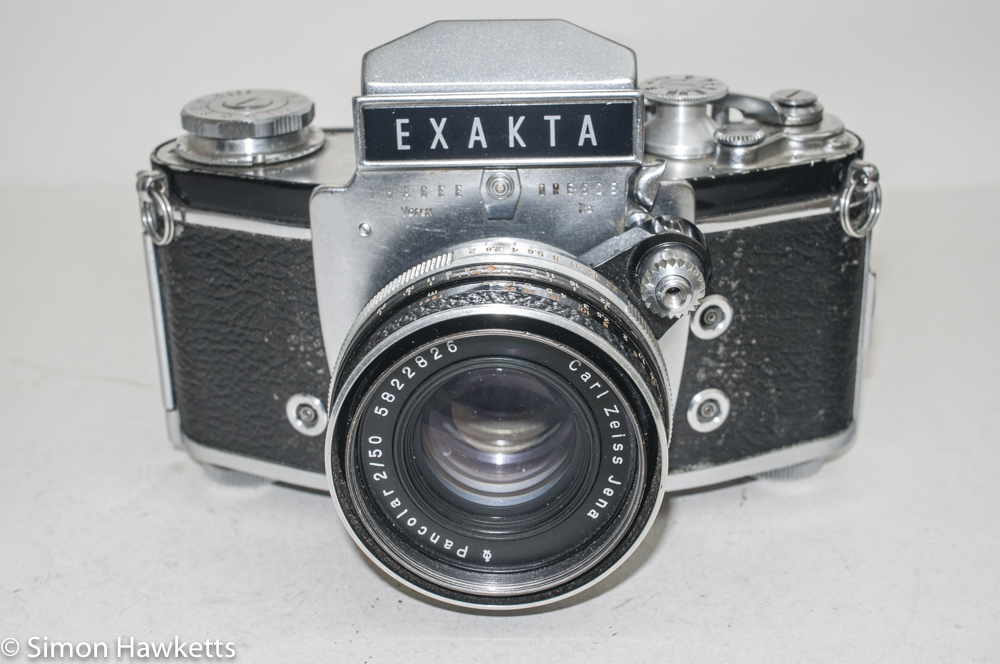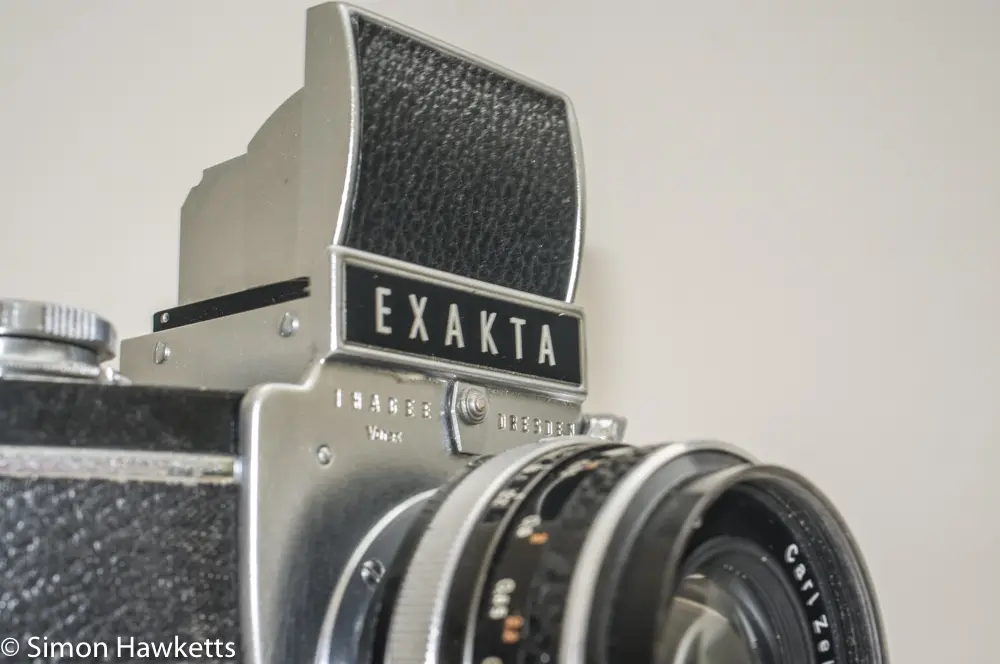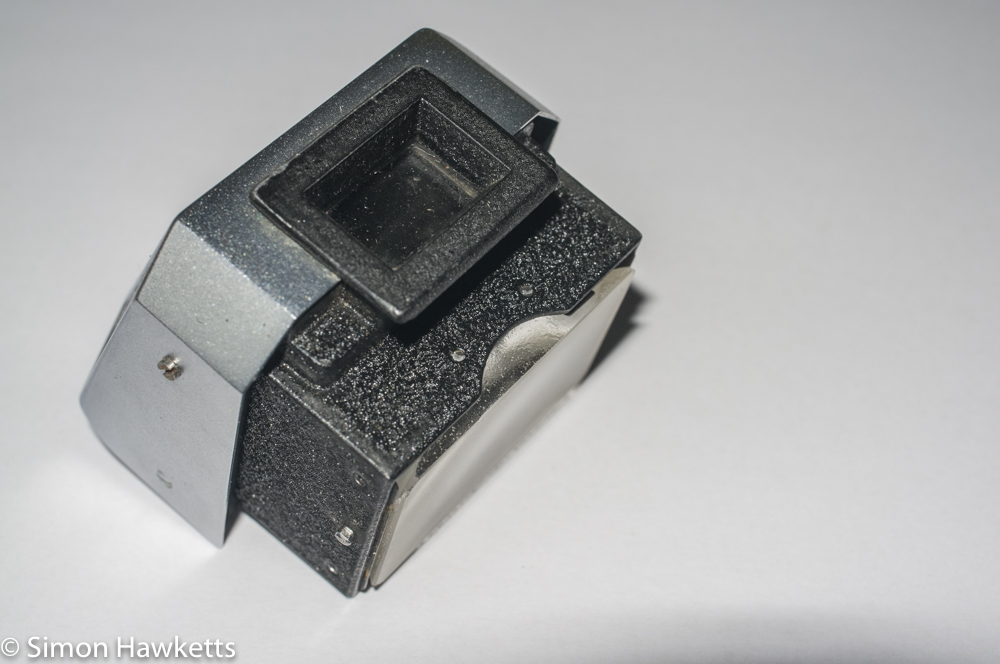Exakta Varex IIa 35 mm SLR camera
I have several Exakta Exa cameras in my collection, but this Exakta Varex IIa is the first of the ‘top flight’ Exakta models I’ve acquired. The model was produced in a variety of different styles and variations over quite a long time period, and the example I own is one of the later variants.
Exakta Varex IIa Images





















My Exakta Varex IIa Camera
I bought this camera simply because I’d bought several Exa models and had been impressed with the build quality and style of those cameras. Since the Exa series was a ‘cut down’ cheap model, I thought I’d like to own one of the proper Exakta models, and so I bought this, along with the attached Carl Zeiss Jena Pancolar 50 mm f/2 lens, for about £16.
The camera was advertised on eBay as being ‘fully functional’ and when it turned up a couple of days after the end of the auction I confirmed that, generally speaking, that is true. All the shutter speeds are about right, including the slow speeds and the self-timer, and the shutter blinds work so as far as I can see without running a film through the camera everything seems right. Another plus is that the mirror is quite good with only a few spots and some dust which will hopefully come off with some careful cleaning.
The viewfinder fitted was an eye level finder which has some dirt and minor scratches, but I also have a waist level finder fitted to my Exa 1 which also fits this camera, so that gives me a more complete set. Since the focusing screen is easily detachable on the Exakta finders, I should be able to clean the eye level finder up.
On the negative side, however, the shutter blinds are quite wrinkly and old, and although they seem to be light tight, they really should be replaced. Also, I think I will probably strip the camera down and clean up the mechanism to remove the old oil and grease which any camera of 60 odd years old will have accumulated.
The cosmetic condition of the camera is very good considering its age – most of the paintwork is intact, the chrome work looks good, and the leathers just have a few white spots around the flash sync sockets. With a bit of cleaning and lubrication, this camera should be as good as new.
Exakta Varex IIa Description
The Exakta series was a stylish and sophisticated camera system which was also one of the earliest 35 mm SLR systems made. The Varex IIa model was made for a number of years and had a number of different variants, but most of the changes were cosmetic rather than mechanical. The version I have is one of the later models where the Exakta name plate is a printed black plate in front of the viewfinder.
The basic camera design is a 35 mm SLR camera with a wide range of shutter speeds, comprehensive flash sync options, a replaceable viewfinder system, replaceable lenses and a distinctive body shape. It is a heavy camera, and feels well-made and solid, and had a very large number of accessories and lenses made for it over the 40 or so years that the cameras were made.



The viewfinder is a replaceable system which allows both eye level and waist level finder to be fitted. There is a small lever on the front of the camera which releases the viewfinder, so it can be pulled out of the camera body. As well as the standard viewfinders, there were also finders made which included a light meter built into the top, although I currently don’t own one of those models.
The viewfinders are a design which easily allows the focus screen to be removed for cleaning and different focus screens were available which included split image, plain ground glass etc.
The shutter speed setting arrangement, is one of the most sophisticated I’ve seen on a mechanical camera. There are two speed dials, a fast setting dial on the left-hand side, which sets the speeds of 1/1000 to 1/25sec and bulb and time settings.
Then on the other side, there is a large dial which controls shutter speeds of 1/5, 1/2, 1sec, 2sec, 4sec, 6sec, 8sec, 10sec & 12sec (yes 12 seconds shutter time). Also on this dial is the self-timer dial which allows you to dial in shutter delays and these can be applied to any of the pre-set times. It is an impressive arrangement of shutter times for a camera which was first made in the 1930s!
One warning about the shutter speed setting – make sure the shutter is cocked before setting the speed. It is possible to damage the mechanism if it is adjusted before the shutter is cocked. Since the mirror is a non-return design it’s probably best to get into a habit of winding the film, composing the picture, setting the exposure and then release the shutter.
Back to the controls; On the same side as the fast shutter speed dial is the film advance lever and the frame counter. Both of these are a bit odd in their operation. The film advance lever has a very long throw of about 300 deg, which is quite difficult to do in a hurry. Also, being on the left-hand side of the camera means that for anyone who is right-handed, it seems to feel a bit odd. The frame counter, which is built into the film advance pillar, is odd because the counter increments when the shutter is fired rather than when the film is advanced.
Talking of the film transport, here is another oddity about the Exakta.
There is a removable take up spool in the camera which can be removed and replaced with a standard 35 mm film cassette. This allows you to wind film out of a full cassette and into an empty cassette – nothing spectacularly interesting there, but what is interesting is that there is a cutter built into the camera which allows you to cut the film and remove the partially exposed film to be developed!
On the bottom of the camera, next to the film rewind spool is a small knurled knob, and when it is undone and the attached shaft withdrawn it pulls a blade down the film cutting it just next to the unexposed film cassette. I don’t know of any other camera which had this feature.
For flash sync, the Varex IIa supplies three different sockets to provide sync for flash bulbs (M & F) or electronic flash (X) and these are fitted on the front panel of the camera. Also fitted to the front panel is the shutter release button, with a swing over cap which acts as a shutter lock. The reason the release is fitted to the front panel is so that a PAD (pressure activated diaphragm) lens can be used, which will close the lens aperture before the shutter is closed.
The lens supplied with the camera is a Carl Zeiss Jena Pancolar 50 mm f/2 lens, which has quite a good reputation for sharpness and colour definition. The lens has a slight problem with the shutter which is a bit reluctant to both stop down and open up, which is probably due to oil contamination and should hopefully be reasonably easy to fix.
The Pancolar was one of the many lens units supplied with the camera, but the Exakta bayonet was a very popular lens mount and literally thousands of lenses were made, including some very high quality units. As I build up my Exakta collection, I hope to add some more of the classic lenses as well as some other body designs.
The next move for this camera is a strip down and clean up of the mechanism and check the condition of the shutter blinds to see if they are OK or if they need to be replaced.
Exakta Varex IIa Specification
- Exakta Varex IIa 35mm slr camera
- Extensive mechanical shutter times of 12sec to 1/1000 sec
- Self timer
- Replaceable viewfinder
- Exakta bayonet lens mount
- Non return mirror design
- Film cutter
- Film type reminder
- Table top stand built into camera
- Removable back door
- Removable take up spool which can be replaced with empty cassette
- Flash sync sockets for type X, M and F flash
- Front mounted shutter release with lock
- Cable release thread in shutter release
- Manually settable frame counter
- Long throw film advance
- Fitted with 50mm f/2 Carl Zeiss Jena Pancolar lens
- Body Ser No: 993666
- Lens Ser No: 5822826
- Manual available on-line here
Discover more from Everything Vintage
Subscribe to get the latest posts sent to your email.







